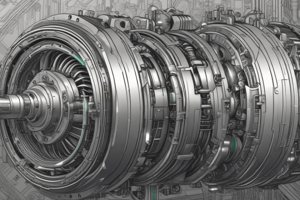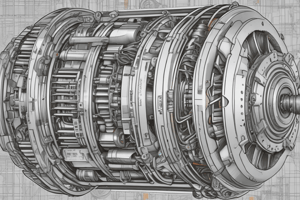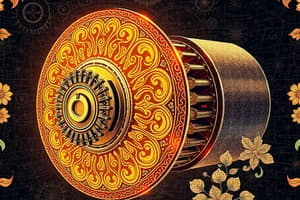Podcast
Questions and Answers
What is the relationship between torque and armature current in a DC series motor before magnetic saturation?
What is the relationship between torque and armature current in a DC series motor before magnetic saturation?
- Ta ∝ √Ia
- Ta ∝ Ia
- Ta ∝ Ia^2 (correct)
- Ta ∝ 1/Ia
What is the shape of the Ta-Ia curve in a DC series motor before magnetic saturation?
What is the shape of the Ta-Ia curve in a DC series motor before magnetic saturation?
- Exponential
- Hyperbola
- Linear
- Parabola (correct)
What is the relationship between speed and armature current in a DC series motor for small load currents?
What is the relationship between speed and armature current in a DC series motor for small load currents?
- N ∝ Ia
- N ∝ √Ia
- N ∝ 1/√Ia
- N ∝ 1/Ia (correct)
Why do DC series motors require high starting torque?
Why do DC series motors require high starting torque?
What is the relationship between back emf and speed in a DC motor?
What is the relationship between back emf and speed in a DC motor?
When the armature current is very small in a series motor, what happens to the speed?
When the armature current is very small in a series motor, what happens to the speed?
What is the relationship between torque and armature current in a DC shunt motor?
What is the relationship between torque and armature current in a DC shunt motor?
Why should a DC series motor not be started without a mechanical load?
Why should a DC series motor not be started without a mechanical load?
What is the characteristic of a differential compound motor?
What is the characteristic of a differential compound motor?
What is the effect of armature reaction on the flux in a DC motor?
What is the effect of armature reaction on the flux in a DC motor?
What is the main disadvantage of the plugging method of breaking?
What is the main disadvantage of the plugging method of breaking?
What is the main advantage of electrical braking over mechanical braking?
What is the main advantage of electrical braking over mechanical braking?
What is a characteristic of electrical braking that is not possible in mechanical braking?
What is a characteristic of electrical braking that is not possible in mechanical braking?
What is the primary function of the gearbox in a DC servo motor construction?
What is the primary function of the gearbox in a DC servo motor construction?
What type of motor is used in a DC servo motor construction?
What type of motor is used in a DC servo motor construction?
What is the primary reason for the decrease in speed of a DC shunt motor when the torque is increased?
What is the primary reason for the decrease in speed of a DC shunt motor when the torque is increased?
What is the main disadvantage of dynamic breaking or rheostat breaking?
What is the main disadvantage of dynamic breaking or rheostat breaking?
What is the necessary condition for regenerative breaking to occur in a DC motor?
What is the necessary condition for regenerative breaking to occur in a DC motor?
What is the primary function of the current limiting resistor in plugging or reverse current breaking?
What is the primary function of the current limiting resistor in plugging or reverse current breaking?
What is the main difference between regenerative breaking and plugging or reverse current breaking?
What is the main difference between regenerative breaking and plugging or reverse current breaking?
What is the primary function of a position sensor in a DC servo motor system?
What is the primary function of a position sensor in a DC servo motor system?
What is the purpose of the comparator in a DC servo motor system?
What is the purpose of the comparator in a DC servo motor system?
What is the advantage of an armature-controlled DC servo motor over a field-controlled DC servo motor?
What is the advantage of an armature-controlled DC servo motor over a field-controlled DC servo motor?
What determines the speed of a DC servo motor?
What determines the speed of a DC servo motor?
What is the significance of the transfer function in a DC servo motor?
What is the significance of the transfer function in a DC servo motor?
What is the primary characteristic of a DC servo motor in terms of speed control?
What is the primary characteristic of a DC servo motor in terms of speed control?
What is the main difference between a DC servo motor and an AC servo motor in terms of output power?
What is the main difference between a DC servo motor and an AC servo motor in terms of output power?
What is the typical angle of rotation of a stepper motor?
What is the typical angle of rotation of a stepper motor?
What is the purpose of having a 20 to 30% margin between the load necessities and motor ratings in DC servo motors?
What is the purpose of having a 20 to 30% margin between the load necessities and motor ratings in DC servo motors?
What is the advantage of using DC servo motors over AC servo motors in terms of noise?
What is the advantage of using DC servo motors over AC servo motors in terms of noise?
What is the primary difference between a bipolar and unipolar stepper motor?
What is the primary difference between a bipolar and unipolar stepper motor?
How do stepper motors achieve precise movement?
How do stepper motors achieve precise movement?
What is the advantage of a brushless DC motor over a brushed DC motor?
What is the advantage of a brushless DC motor over a brushed DC motor?
What is the primary function of the controller in a brushless DC motor?
What is the primary function of the controller in a brushless DC motor?
What is the difference between an inner rotor and outer rotor design in brushless DC motors?
What is the difference between an inner rotor and outer rotor design in brushless DC motors?
What is the advantage of using more electromagnets on the stator in a brushless DC motor?
What is the advantage of using more electromagnets on the stator in a brushless DC motor?
What is the characteristic of a brushless DC motor that allows it to operate at high speeds?
What is the characteristic of a brushless DC motor that allows it to operate at high speeds?
Why do brushless DC motors produce less noise during operation?
Why do brushless DC motors produce less noise during operation?
What is the primary advantage of inner rotor designed brushless DC motors?
What is the primary advantage of inner rotor designed brushless DC motors?
What is the primary advantage of brushless DC motors over stepper motors?
What is the primary advantage of brushless DC motors over stepper motors?
Flashcards are hidden until you start studying
Study Notes
Characteristics of DC Motors
- Three characteristic curves are important for DC motors:
- Torque vs. armature current
- Speed vs. armature current
- Speed vs. torque
- These characteristics are determined by the relations: Ta ∝ ɸ.Ia and N ∝ Eb/ɸ
- Back emf (Eb) is given by the emf equation of a dc generator: Eb = PɸNZ / 60A
Characteristics of DC Series Motors
- Torque vs. armature current (Ta-Ia):
- Before magnetic saturation, Ta α Ia2
- After magnetic saturation, Ta ∝ Ia
- The curve becomes a straight line after magnetic saturation
- Shaft torque (Tsh) is less than armature torque (Ta) due to stray losses
- Speed vs. armature current (N-Ia):
- Speed is inversely proportional to ɸ
- Speed is inversely proportional to Ia for small currents
- Speed becomes dangerously high when armature current is very small
- Speed vs. torque (N-Ta):
- When speed is high, torque is low, and vice versa
Characteristics of DC Shunt Motors
- Torque vs. armature current (Ta-Ia):
- Torque is proportional to armature current
- The Ta-Ia characteristic is a straight line through the origin
- Speed vs. armature current (N-Ia):
- Speed remains almost constant
- The speed decreases only by 5 to 15% of full load speed
Characteristics of DC Compound Motors
- Cumulative compound motor:
- Series winding takes care of heavy load
- Shunt winding prevents the motor from running at high speed when the load is removed
- Used in applications where high starting torque is required
- Differential compound motor:
- Total flux decreases with increase in load
- Speed remains almost constant or increases with increase in load
- Used in limited applications in experimental and research work
Speed-Torque Characteristics of DC Shunt Motor
- The speed-torque characteristics are obtained from torque-current and speed-current characteristics
- The expression for back e.m.f is given by Eb = kaϕN
- The expression for torque is given by T = kaϕIa
- The speed-torque characteristics are affected by the armature reaction
Types of Electric Breaking
- Rheostat Breaking or Dynamic Breaking:
- Armature is disconnected from the supply and connected across a breaking resistance Rb
- The motor works as a generator, producing a breaking torque
- The kinetic energy of moving parts is converted into electrical energy and dissipated in the form of heat
- Regenerative Breaking:
- The motor is operated as a generator, converting kinetic energy into electrical energy
- The electrical energy is returned to the supply source
- The motor slows down, but does not come to a complete stop
- Plugging or Reverse Current Breaking:
- The connections of the armature are reversed, providing a breaking effect
- The motor tends to rotate in the opposite direction
- The supply voltage and back emf act in the same direction, producing a high breaking torque
Comparison between Electrical Braking and Mechanical Braking
-
Cost: Electrical braking has a high initial cost, while mechanical braking has a low initial cost
-
Maintenance: Electrical braking requires very little maintenance, while mechanical braking requires frequent maintenance
-
Replacement of brake shoes: Electrical braking does not require replacement of brake shoes, while mechanical braking requires frequent replacement
-
Maintenance cost: Electrical braking has a low maintenance cost, while mechanical braking has a high maintenance cost
-
Production of metal dust: Mechanical braking produces metal dust, which causes wearing of bearings, while electrical braking does not produce metal dust
-
Braking action: Electrical braking provides a gradual and smooth braking action, while mechanical braking provides a sudden braking action
-
Heat production: Electrical braking produces heat at a convenient place, while mechanical braking produces heat in brake shoes, which may damage the brake lining
-
Regenerative braking: Electrical braking allows for regenerative braking, while mechanical braking does not
-
Used alone or supplemented: Electrical braking is alone not sufficient, and it is supplemented by mechanical braking, while mechanical braking can be used alone### Motors
-
Convert electrical energy to mechanical motion in the form of a rotor rotating around a stationary axis
-
Used in various applications, including security cameras, smart locks, and 3D printers
Stepper Motors
- Convert electrical pulses into precise mechanical motion
- Operate in discrete steps, with each step being a precise angle of rotation (typically 1.8°)
- Main components:
- Rotor: rotating component with teeth or magnetic poles
- Stator: stationary segment with coils of wire that produce magnetic fields
- Winding phases: either bipolar or unipolar, with different numbers of phases and windings
- Pulses and control: sequence of electrical pulses determines direction and distance of each step
- Highly precise and controllable, ideal for position-holding tasks, such as robotics and camera gimbals
Brushless Motor (BLDC)
- Electronically commutated DC motor without brushes
- Controller provides pulses of current to motor windings, controlling speed and torque
- Highly efficient, producing a large amount of torque over a wide speed range
- Smooth operation and holding torque when stationary
- Two main parts: rotor and stator
- Rotor: rotating part with permanent magnets
- Stator: stationary part with stator windings
Working of Brushless DC Motor
- Similar to brushed motor, but with electronic commutation instead of brushes
- Rotor magnets move the electromagnets to the stator
- High power transistors activate electromagnets for shaft turns
- Controller performs power distribution using a solid-state circuit
Types of Brushless DC Motors
- Outer rotor motor and inner rotor motor
- Main difference: design and heat dissipation
- Inner rotor design: rotor in the center, stator winding surrounds it, producing more torque and heat dissipation
- Outer rotor design: rotor surrounds the winding, trapping heat inside and operating at lower rated current
Advantages of Brushless DC Motor
- More efficient, with velocity determined by frequency of current supply
- No mechanical energy loss due to friction
- Can operate at high-speed under any condition
- No sparking, less noise, and more precise control
- Low rotor inertia, high performance, and large torque per cubic inch
- Reliable, maintenance-free, and less electromagnetic interference
- No air flow required for inside cooling
Disadvantages of Brushless DC Motor
- Cost more than brushed DC motor
- Limited high power supply, otherwise heat can damage magnets and insulation
- May weaken magnets and insulation if too much heat is generated
Studying That Suits You
Use AI to generate personalized quizzes and flashcards to suit your learning preferences.





